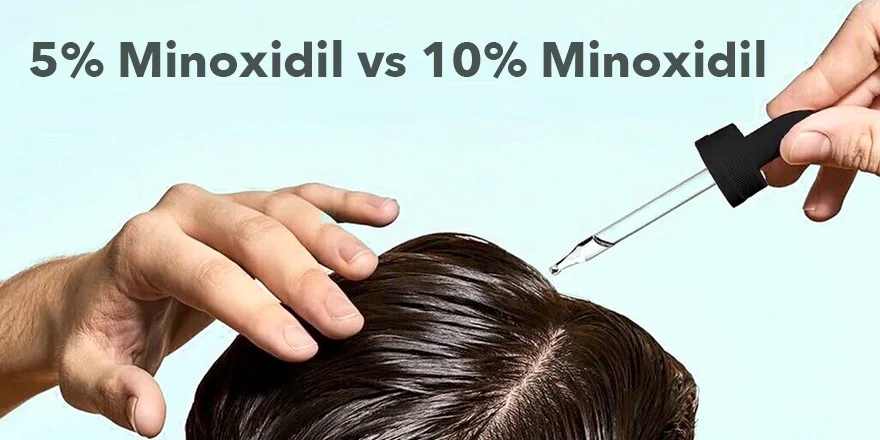10% Minoxidil vs. 5% Minoxidil: Which Is Right for You?
Hair loss is a common concern for many individuals, and finding an effective solution is a top priority for those seeking to regrow hair or prevent further thinning. Minoxidil, a topical medication, has long been a popular choice for promoting hair growth. While the standard concentration is 5%, some formulations offer a higher concentration of 10%. In this article, we’ll explore the pros and cons of 10% Minoxidil versus 5% Minoxidil to help you make an informed decision about which might be the right choice for your hair care journey.
Understanding Minoxidil
Before delving into the differences between 10% and 5% Minoxidil, it’s important to understand how this medication works. Minoxidil was initially developed as an oral medication to treat high blood pressure. However, its unexpected side effect of stimulating hair growth led to the development of topical formulations specifically for addressing hair loss.
The Mechanism of Action
Minoxidil is believed to widen blood vessels, increase blood flow to hair follicles, and stimulate hair follicles’ activity. This process prolongs the growth phase of hair, encourages the development of thicker strands, and may revitalize shrunken hair follicles, ultimately promoting hair regrowth.
The Case for 10% Minoxidil
Pros:
- Higher Minoxidil Concentration: The most apparent advantage of 10% Minoxidil is its higher concentration of the active ingredient. This higher dose is intended to provide a more potent effect, potentially leading to faster and more noticeable results for some users.
- Improved Efficacy: Some studies suggest that a higher concentration of Minoxidil may be more effective in promoting hair growth, especially for individuals who have not responded well to lower concentrations. The increased potency may offer enhanced benefits for those with more advanced hair loss.
- Increased Blood Flow: The higher concentration may further enhance blood flow to the scalp, providing better nourishment to hair follicles. Improved circulation can contribute to a healthier scalp environment, which is conducive to optimal hair growth.
- Potential for Better Results in Resistant Cases: Individuals who have not experienced significant improvement with 5% Minoxidil might find 10% Minoxidil to be a more effective solution. This higher concentration is often considered when lower concentrations have not yielded the desired results.
Cons:
- Increased Risk of Side Effects: With a higher concentration comes an increased risk of side effects. Individuals using 10% Minoxidil may be more prone to skin irritation, itching, redness, and dryness. It’s crucial to be vigilant about monitoring for adverse reactions and adjusting usage accordingly.
- Not FDA-Approved: As of my last knowledge update in January 2022, 10% Minoxidil is not FDA-approved, while 5% Minoxidil is widely accepted and recommended by healthcare professionals. The lack of FDA approval means that the safety and efficacy of the 10% concentration may not be as well-established.
- Cost Consideration: Higher concentrations often come with a higher price tag. Individuals considering 10% Minoxidil should weigh the potential benefits against the increased cost, especially since there may be effective alternatives available at lower concentrations.
The Case for 5% Minoxidil
Pros:
- Established Safety and Efficacy: One of the primary advantages of 5% Minoxidil is its long history of use and FDA approval. This concentration has been extensively studied and proven effective in promoting hair growth while maintaining a favorable safety profile.
- Lower Risk of Side Effects: Compared to 10% Minoxidil, the lower concentration is generally associated with a reduced risk of side effects. Many users tolerate 5% Minoxidil well, experiencing minimal or manageable skin reactions.
- Widely Available: 5% Minoxidil is readily available over the counter in various formulations, including liquid, foam, and topical solutions. Its accessibility makes it a convenient option for individuals looking for an effective and widely recognized solution to hair loss.
- Cost-Effective: In terms of affordability, 5% Minoxidil is often more cost-effective than higher concentrations. For those on a budget or seeking a reliable and established solution, the lower concentration may be a more practical choice.
Cons:
- Potentially Slower Results: Some users may find that the results with 5% Minoxidil take longer to become noticeable compared to a higher concentration. However, patience and consistency in application are key factors in achieving optimal results with any concentration.
- Limited Effectiveness for Some Users: Individuals with advanced hair loss or those who have not responded well to 5% Minoxidil in the past might find the lower concentration less effective. In such cases, exploring higher concentrations under the guidance of a healthcare professional may be considered.
Choosing the Right Concentration for You
The decision between 10% and 5% Minoxidil ultimately depends on individual factors, including the severity of hair loss, previous response to treatments, tolerance for potential side effects, and budget considerations. Before making a decision, it is advisable to consult with a healthcare professional or a dermatologist who can provide personalized advice based on your specific needs and medical history.
Conclusion
In the quest for hair regrowth, the choice between 10% and 5% Minoxidil involves weighing the potential benefits against the associated risks and considering individual factors. While 10% Minoxidil offers a higher concentration that may lead to faster results for some, it comes with an increased risk of side effects and lacks FDA approval. On the other hand, 5% Minoxidil has a long history of established safety and efficacy but may be perceived as slower in producing results.
Ultimately, the best approach is to make an informed decision with the guidance of a healthcare professional. Understanding your unique circumstances, goals, and preferences will help determine whether 10% or 5% Minoxidil is the right choice to address your hair loss concerns.

